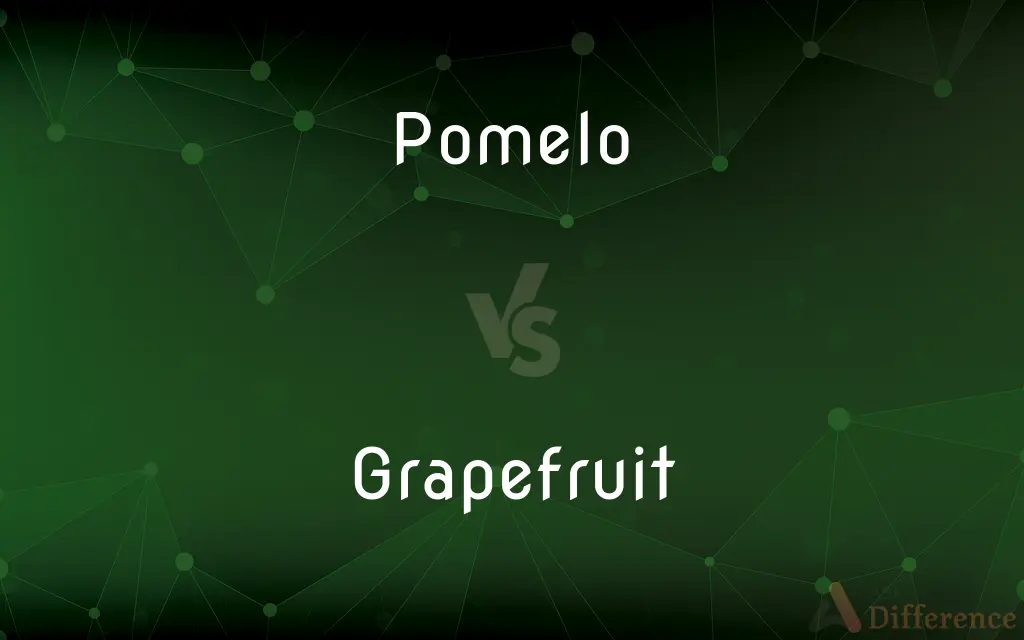Pomelo vs. Grapefruit — What's the Difference?
By Fiza Rafique & Urooj Arif — Updated on April 4, 2024
Pomelo is the largest citrus fruit with sweet to slightly bitter taste, while grapefruit is a hybrid, smaller, and ranges from sweet to very bitter.

Difference Between Pomelo and Grapefruit
Table of Contents
ADVERTISEMENT
Key Differences
Pomelos, originating in Southeast Asia, are the largest citrus fruits, known for their thick, green or yellow rind and sweet, less bitter flesh compared to grapefruits. They are often eaten fresh or used in desserts and salads. Grapefruits, believed to be a hybrid of pomelo and sweet orange, are smaller, with a thinner rind that can be yellow-orange or pink-red, and their flesh varies widely in flavor from sweet to very bitter, making them versatile in both sweet and savory dishes.
The taste of pomelos is generally milder and sweeter, with less of the bitterness that characterizes grapefruits. This makes pomelos more palatable to some people when eaten fresh. Grapefruits, however, have a stronger, more acidic taste with a significant bitter undertone, which can be reduced by cooking or pairing with sweeteners.
Both fruits are rich in vitamins, particularly vitamin C, fiber, and antioxidants, but grapefruits contain higher amounts of certain compounds like naringenin, which has been studied for its potential health benefits, including anti-inflammatory and antioxidant effects. Pomelos may have more vitamin C in some cases, depending on the variety and ripeness.
Pomelos have a significant role in certain Asian traditions and festivals, symbolizing prosperity and good fortune. They are often used as offerings in temples or given as gifts during the Lunar New Year. Grapefruits, while popular worldwide, do not have as specific cultural significance but are widely consumed in many diets for their health benefits and as part of weight loss programs due to their low calorie and high fiber content.
The growing conditions for pomelos and grapefruits also differ, with pomelos preferring tropical to subtropical climates, reflecting their Southeast Asian origins. Grapefruits, on the other hand, have adapted to a wider range of climates, from subtropical to temperate, making them more widely cultivated and available in various regions around the world.
ADVERTISEMENT
Comparison Chart
Origin
Southeast Asia
Believed to be a hybrid of pomelo and sweet orange
Size
Largest citrus fruit
Smaller than pomelo
Taste
Sweet to slightly bitter
Ranges from sweet to very bitter
Nutritional Value
Rich in vitamin C, fiber, antioxidants
Higher in certain compounds like naringenin
Cultural Significance
Symbolizes prosperity and good fortune in Asia
Consumed worldwide, associated with health benefits
Growing Conditions
Tropical to subtropical climates
Adaptable to subtropical to temperate climates
Compare with Definitions
Pomelo
Less bitter than grapefruits.
Pomelos are favored for their milder, sweeter taste when eaten fresh.
Grapefruit
Known for its bitter and acidic taste.
Grapefruits are often sweetened with sugar or honey to balance their bitterness.
Pomelo
The largest citrus fruit with thick rind and sweet flesh.
The pomelo is often used in festive dishes during the Lunar New Year.
Grapefruit
Contains health-promoting compounds like naringenin.
The antioxidant properties of grapefruit are attributed to naringenin.
Pomelo
High in vitamin C and antioxidants.
A pomelo can provide a significant portion of the daily vitamin C requirement.
Grapefruit
Adapts to a range of climates, from subtropical to temperate.
Florida and Texas are major grapefruit-producing states.
Pomelo
Grown in tropical to subtropical climates.
Pomelos are extensively cultivated in Thailand and Malaysia.
Grapefruit
Popular in diets and health programs.
Grapefruit is a staple in many weight loss diets due to its low calorie content.
Pomelo
Symbol of prosperity in Asian culture.
Pomelos are displayed in homes during certain festivals to bring good luck.
Grapefruit
A citrus hybrid with a thinner rind and varied flavors.
Grapefruit varieties range from the sweet Ruby Red to the bitter White.
Pomelo
The pomelo (), pummelo (), or in scientific terms Citrus maxima or Citrus grandis, is the largest citrus fruit from the family Rutaceae and the principal ancestor of the grapefruit. It is a natural, i.e., non-hybrid, citrus fruit, native to Southeast Asia.
Grapefruit
The grapefruit (Citrus × paradisi) is a subtropical citrus tree known for its relatively large, sour to semisweet, somewhat bitter fruit. The interior flesh is segmented and varies in color from pale yellow to dark pink.
Pomelo
The largest of the citrus fruits, with a thick yellow skin and bitter pulp which resembles grapefruit in flavour.
Grapefruit
A tropical or semitropical evergreen tree (Citrus paradisi) cultivated for its edible fruit.
Pomelo
The tree which bears the pomelo.
Grapefruit
The large, round fruit of this tree, having a yellow rind and juicy, somewhat acid pulp.
Pomelo
A tropical Southeast Asian tree (Citrus maxima) closely related to the grapefruit and having very large round fruit with a thick rind and coarse-grained pulp.
Grapefruit
The tree of the species Citrus paradisi, a hybrid of pomelo (Citrus maxima) and sweet orange.
Pomelo
The edible yellow fruit of this tree. In both senses also called shaddock.
Grapefruit
The large spherical tart fruit produced by this tree.
Pomelo
The large fruit of the Citrus maxima (syn. Citrus grandis), native to South Asia and Southeast Asia, with a thick green or yellow rind, a thick white pith, and semi-sweet translucent pale flesh.
Grapefruit
A citrus tree (Citrus paradisi) bearing large round edible fruit having a thick yellow rind and juicy somewhat acid pulp.
Pomelo
The tree which produces this fruit.
Grapefruit
The large yellow fruit of the Citrus paradisi, having somewhat acid juicy pulp. It is a popular breakfast food.
Pomelo
The grapefruit.
Grapefruit
Citrus tree bearing large round edible fruit having a thick yellow rind and juicy somewhat acid pulp
Pomelo
A variety of shaddock, called also grape fruit.
Grapefruit
Large yellow fruit with somewhat acid juicy pulp; usual serving consists of a half
Pomelo
Southeastern Asian tree producing large fruits resembling grapefruits
Pomelo
Large pear-shaped fruit similar to grapefruit but with coarse dry pulp
Common Curiosities
Are pomelos sweeter than grapefruits?
Generally, yes, pomelos are considered sweeter and less bitter than grapefruits.
Why is grapefruit called a hybrid?
Grapefruit is believed to have originated as a hybrid of the pomelo and sweet orange, combining traits of both.
What are the health benefits of eating pomelo and grapefruit?
Both are rich in vitamin C and fiber and contain antioxidants, which support immune function and may offer other health benefits.
Is there a cultural significance to grapefruits like there is with pomelos in Asia?
While grapefruits are valued for their health benefits, they don't hold the same cultural significance as pomelos in Asian traditions.
What's the best way to eat pomelo and grapefruit?
They can be eaten fresh, added to salads, or used in recipes. Pomelos are easier to eat fresh due to their sweeter taste.
What makes pomelo different from grapefruit?
Pomelo is larger, with a thicker rind and sweeter taste, while grapefruit is smaller, has a thinner rind, and a more varied taste profile.
How do I choose a ripe pomelo or grapefruit?
Look for fruits that are heavy for their size and have a slight give when pressed; the skin should be smooth and shiny.
Can I substitute grapefruit for pomelo in recipes?
Yes, but expect a difference in bitterness and acidity, as grapefruits can be more bitter and acidic than pomelos.
How should pomelo and grapefruit be stored?
Both can be stored at room temperature for a few days or in the refrigerator to extend freshness for up to a week or more.
Can everyone eat grapefruit?
No, grapefruit can interact with certain medications, so it's important to consult with a healthcare provider if you're on medication.
Can the rind of pomelo and grapefruit be used?
Yes, the rinds can be candied or used as zest in cooking and baking for added flavor.
Why do pomelos have a thicker rind compared to grapefruits?
The thicker rind of pomelos is a natural characteristic, possibly evolved as protection against pests and environmental factors.
What is the nutritional difference between pomelo and grapefruit?
While both are nutritionally similar, grapefruit may contain higher levels of certain beneficial compounds like naringenin.
How do pomelo and grapefruit affect weight loss?
Their high fiber content and low calories make them suitable for weight loss diets, promoting satiety and reducing overall calorie intake.
Are there different varieties of pomelo and grapefruit?
Yes, both fruits come in various varieties, with differences in size, color, and taste.
Share Your Discovery

Previous Comparison
Congress vs. Convention
Next Comparison
Congrats vs. CongratzAuthor Spotlight
Written by
Fiza RafiqueFiza Rafique is a skilled content writer at AskDifference.com, where she meticulously refines and enhances written pieces. Drawing from her vast editorial expertise, Fiza ensures clarity, accuracy, and precision in every article. Passionate about language, she continually seeks to elevate the quality of content for readers worldwide.
Co-written by
Urooj ArifUrooj is a skilled content writer at Ask Difference, known for her exceptional ability to simplify complex topics into engaging and informative content. With a passion for research and a flair for clear, concise writing, she consistently delivers articles that resonate with our diverse audience.
















































